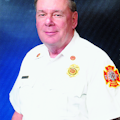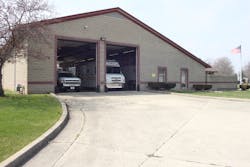Hazmat Studies: Inside the Greater Cincinnati Hazmat Unit
The Greater Cincinnati Hazmat Unit (GCHMU) is a non-governmental, nonprofit volunteer organization that provides hazmat services to multiple counties and states.
GCHMU basics
Originally organized in 1990, GCHMU has an annual operations budget of $170,000. Funding is provided by public funds from emergency management agencies in the covered entities.
GCHMU currently contracts with 10 entities in Ohio, Indiana and Kentucky. In Ohio: City of Fairfield, Hamilton County, Clermont County, Brown County and Warren County; in Kentucky: Campbell County and Fort Wright; and in Indiana: Dearborn County, Ohio County and Franklin County.
GCHMU operates out of its main station and office in Sharonville, OH, a city with a population of 13,581 (per 2014 data) and located within the Cincinnati metropolitan area. Additional equipment is located at fire stations in their response area. Fire departments provide drivers for the equipment kept in their stations.
GCHMU’s coverage area includes approximately 1,470,000 people in approximately 2,638 square miles. The team is a certified Type 1 team in Ohio—the highest level—and they can be called anywhere in the state if needed.
Governance and response
GCHMU is governed by a Board of Trustees formed by representatives of each of the entities served by the team. Board members can come from the fire service, the public, local government and in-state businesses. Team members come from emergency response agencies and private industry throughout the response area, and can include firefighters, EMTs, paramedics, law enforcement officers, and industry representatives.
GCHMU responds to both major and minor incidents. The team has more than 20 years of experience and is capable of handling multiple incidents at one time, making multiple entries, and sustaining a 24-hour operation. On average, the team responds to around 25 incidents per year, with five of them being full-team responses. If additional help is needed, they request mutual aid from the City of Cincinnati.
Chief Don Bennett of the Fairfield, OH, Fire Department is the president of the GCHMU Board of Directors and the chief of the response unit. Four duty officers—Chief Bennett; BJ Jetter PhD, chief of Monroe Township, OH, Fire Department; Captain Dennis Waldbillig, Deerfield Township, OH, Fire Department; and Tim Deye, Fort Wright, KY, Fire & EMS—are the main contacts for the response team. One duty officer is on call at all times year-round. Only the duty officer can call for full-team activation. Some calls are handled by duty officers without activating the full team and, in some cases, the duty officer responds and handles the request for assistance, again without the full team. Once the duty officer arrives on scene, he may also activate the full team if needed. During normal business hours, Office Administrator Brook Matzen is a contact for the team as well.
There are currently 129 members on the team and four chemists. Team members are alerted by text message and Active911, a digital messaging system that delivers alarms, maps and other critical information instantly to first responders. Active911 also allows response efforts to be monitored in real time.
GCHMU has three levels of response:
- Administrative Consultation: The IC may request a duty officer for a phone consultation for resources and information, such as contact with a chemist, clean-up contractor, etc.
- Administrative Response: A duty officer only responds to the scene and provides detection equipment and expertise in mitigation.
- Full-Team Response: Full response includes duty officers, chemists, technicians and appropriate apparatus.
Apparatus and equipment
At its Sharonville headquarters, GCHMU houses one trailer and truck combination with a Gator, an Analytical Response Unit with all monitoring and detection equipment, and Unit 400, the Command and Communications vehicle.
GCHMU’s three truck and trailer combination units are used for all response equipment and can be used as an environmentally controlled dress-out area. With the use of the trailer, everything is in one area for transport, training and sustainment. All three truck and trailer combinations are equipped the same, except only two have Gators.
Located at fire stations in their response area are the two additional truck and trailer combinations, as well as two foam trucks that contain AR-AFFF foam (16- and 55-gallons of foam each) and two foam nozzles that flow 500 gpm. There are also two absorbent trailers that carry ANSUL Spill X absorbent products (acid, base, caustic, formaldehyde), “spaghetti” booms (oil) for universal application, pads (oil) for universal application, pillows, socks, as well as three duty officer trucks.
Unit 400, the Command and Communications vehicle, is under the direction of the GCHMU and funded by GCHMU, Hamilton County Fire Chief’s Association and the Clermont County Fire Chiefs Alliance. Unit 400 was purchased in 2006 with Urban Area Security Initiative (UASI) funds. The unit can be requested by any public safety agency in UASI Region 6. When requested, Unit 400 responds with logistics personnel from a team of 12 who come from area fire departments and the Communications Center.
The Unit includes a Raytheon ACU1000, which allows operators to patch into any radio frequency in any location for radio communications. This can be very useful in a multi-agency operations. According to Raytheon Communications, “The Raytheon JPS Communications ACU-1000 Modular Interconnect System is easily set up and controlled via software, and can be connected to a Wide Area Interoperability System using the WAIS controller.” It can “simultaneously cross-connect different radio networks, connect radio networks to telephone and SATCOM systems.”
Mass decontamination units are positioned throughout the response area, and are able to decon 50 persons per hour. Units are housed at fire stations, and drivers are provided by those fire departments. Technicians and operations personnel can perform decontamination, both gross and mass. Local fire departments handle gas smells and fuel spills up to 25 gallons.Rural departments sometimes require more assistance. Training is held monthly on the second Saturday. The team also participates in Local Emergency Planning Committee (LEPC) exercises annually.
Drones in the future?
GCHMU is constantly looking to improve response operations and find methods to improve safety for response personnel. Several technician-level tactics that require entry into a Hot Zone place them in harm’s way. As such, Bennett and Jetter have been looking into drones for application to hazmat response.
While the team does not yet have on-scene experience with drones, Bennett is a licensed drone pilot and owns his own Phantom 4. Fire department and hazmat use drove his interest in purchasing a drone. With the known hazards of sending personnel into the Hot Zone, the goal is to add a drone to the fleet to lessen the risk and enhance the services provided.
While FAA has a 400-foot height limit for drones, Bennett says, “You would be surprised at what you can see at 400 feet.” A drone can certainly provide a better view and send video and photos that can be reviewed at the Command Post. An added value is that a drone can also zoom in as close as required for a clear view.
Train derailments are one type of incident for which drones are particularly well suited. Train tracks do not always follow highways, often cutting through areas with limited access. Sending in a drone would provide valuable information in an area for which access by foot in a chemical suit or even bunker gear would be difficult at best. With the frequency of ethanol and crude oil shipments, trains with multiple tank cars of the same material are not uncommon. If multiple cars derail, using a drone to size-up the situation would be invaluable.
Jetter ultimately wants to use drones for air monitoring and sampling, but this would require multiple drones, as most drones do not allow for multiple functions at once. Being able to locate a leak at an incident scene and then monitor the air and/or take a sample would not only reduce time on scene, but keep responders out of danger. Because most departments do not handle cleanup, with a drone, in some circumstances, entry by personnel might not be necessary.
They acknowledge that drones are not the replacement for robots or even hazmat personnel; they are just another tool in the toolbox. However, having drones with interchangeability of equipment would certainly make them more valuable.
Of course, once drones are purchased, personnel need to be trained and certified to use them—and this is where preparation comes into play. With their response needs and wants in mind, Bennett and Jetter have been working with the University of Cincinnati Research Institute to address drone usage for the first responder community. Further, the University of Cincinnati has provided seminars and courses for non-degree-seeking students, including Unmanned Aerial Vehicles for Emergency Responders. Both Bennett and Jetter have taken the drones-focused course to learn more about this potential tool for hazmat response.
For more
For additional information about GCHMU, contact Brooke Matzen at (513) 779-0703 or [email protected].
About the Author

Robert Burke
Robert Burke, who is a hazardous materials and fire protection consultant and who served as a Firehouse contributing editor, is a Certified Fire Protection Specialist (CFSP), Fire Inspector II, Fire Inspector III, Fire Investigator and Hazardous Materials Specialist. He has served on state and county hazmat teams. Burke is the author of the textbooks "Hazardous Materials Chemistry for Emergency Responders," "Counter-Terrorism for Emergency Responders," "Fire Protection: Systems and Response," "Hazmat Teams Across America" and "Hazmatology: The Science of Hazardous Materials."
